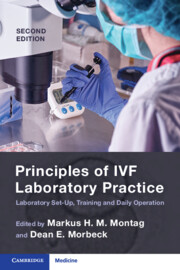Book contents
- Principles of IVF Laboratory Practice
- Principles of IVF Laboratory Practice
- Copyright page
- Contents
- Contributors
- Foreword
- The Evolution of IVF Practice
- Section 1 Starting a New Laboratory and Training Protocols
- Section 2 Pre-procedure Protocols
- Section 3 Gametes
- Section 4 Insemination/ICSI
- Section 5 Fertilization Assessment
- Section 6 Embryo Assessment: Morphology and Beyond
- Chapter 29 Polar Body Biopsy for IVF
- Chapter 30 Embryo Assessment at the Pre-compaction Stage in the IVF Laboratory
- Chapter 31 Embryo Assessment at the Post-compaction Stage in the IVF Laboratory
- Chapter 32 Embryo Assessment at the Blastocyst Stage in the IVF Laboratory
- Chapter 33 Trophectoderm Biopsy for Pre-implantation Genetic Testing
- Chapter 34 Embryo Culture by Time-Lapse: Selection and Beyond
- Section 7 Embryo Cryopreservation
- Section 8 Embryo Transfer
- Section 9 Quality Management
- Index
- References
Chapter 31 - Embryo Assessment at the Post-compaction Stage in the IVF Laboratory
from Section 6 - Embryo Assessment: Morphology and Beyond
Published online by Cambridge University Press: 07 August 2023
- Principles of IVF Laboratory Practice
- Principles of IVF Laboratory Practice
- Copyright page
- Contents
- Contributors
- Foreword
- The Evolution of IVF Practice
- Section 1 Starting a New Laboratory and Training Protocols
- Section 2 Pre-procedure Protocols
- Section 3 Gametes
- Section 4 Insemination/ICSI
- Section 5 Fertilization Assessment
- Section 6 Embryo Assessment: Morphology and Beyond
- Chapter 29 Polar Body Biopsy for IVF
- Chapter 30 Embryo Assessment at the Pre-compaction Stage in the IVF Laboratory
- Chapter 31 Embryo Assessment at the Post-compaction Stage in the IVF Laboratory
- Chapter 32 Embryo Assessment at the Blastocyst Stage in the IVF Laboratory
- Chapter 33 Trophectoderm Biopsy for Pre-implantation Genetic Testing
- Chapter 34 Embryo Culture by Time-Lapse: Selection and Beyond
- Section 7 Embryo Cryopreservation
- Section 8 Embryo Transfer
- Section 9 Quality Management
- Index
- References
Summary
Limitations to embryo culture techniques in the early years of human in vitro fertilization (IVF) required transfer and/or cryopreservation of early cleavage-stage embryos on day 2 and day 3. Embryo quality scoring systems for these early cleavage-stage embryos were simplistic as the number of blastomeres, evenness of blastomere size, placement of blastomeres and extent of fragmentation were very evident. Extended culture of embryos to the blastocyst stage effectively doubled the time these embryos were maintained in vitro. Observations were commonly made at fertilization determination, mid-culture (day 3) and again at the end of the culture period (days 5 and 6). Evaluations of embryos on days 2 and 4 were then skipped in many laboratories. Qualitative selection protocols for morula-stage embryos rely on metrics associated with timing of compaction, extent of compaction, morphology of blastomeres and nuclei, extent of fragmentation and cavitation, if present. This chapter will touch on developmental details integrated into the suggested grading protocol, as well as providing evidence that morulae are overlooked as a viable clinical choice for transfer and for cryopreservation.
- Type
- Chapter
- Information
- Principles of IVF Laboratory PracticeLaboratory Set-Up, Training and Daily Operation, pp. 225 - 231Publisher: Cambridge University PressPrint publication year: 2023



